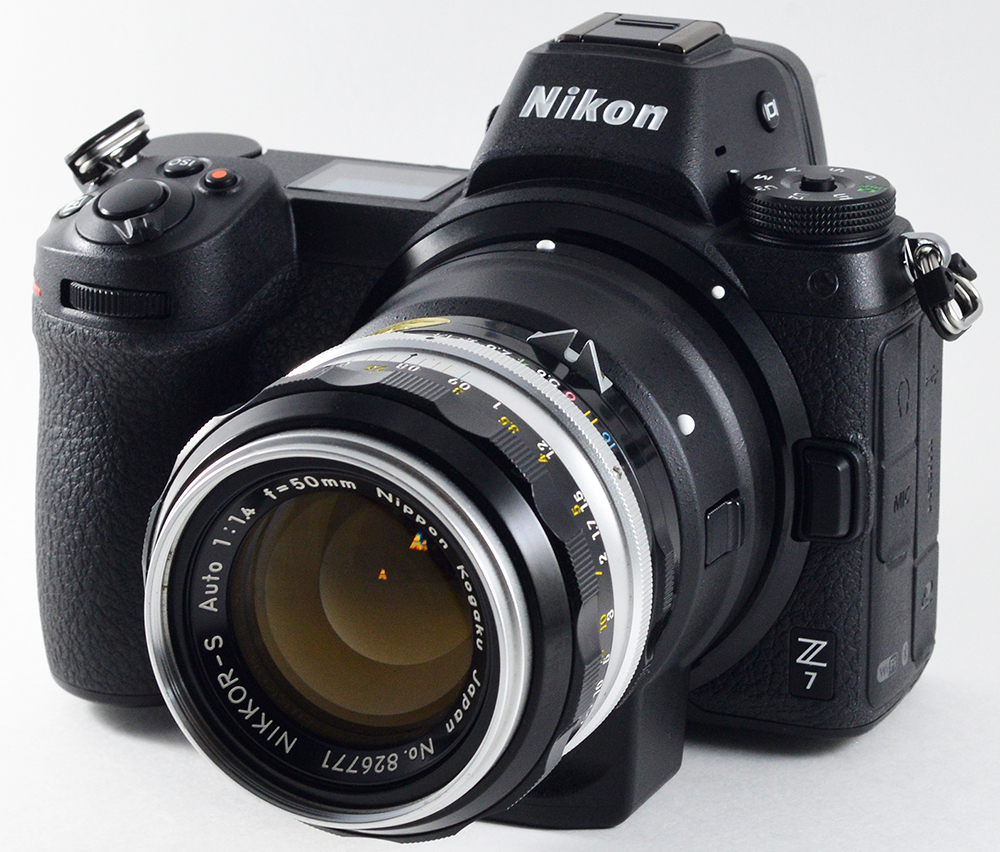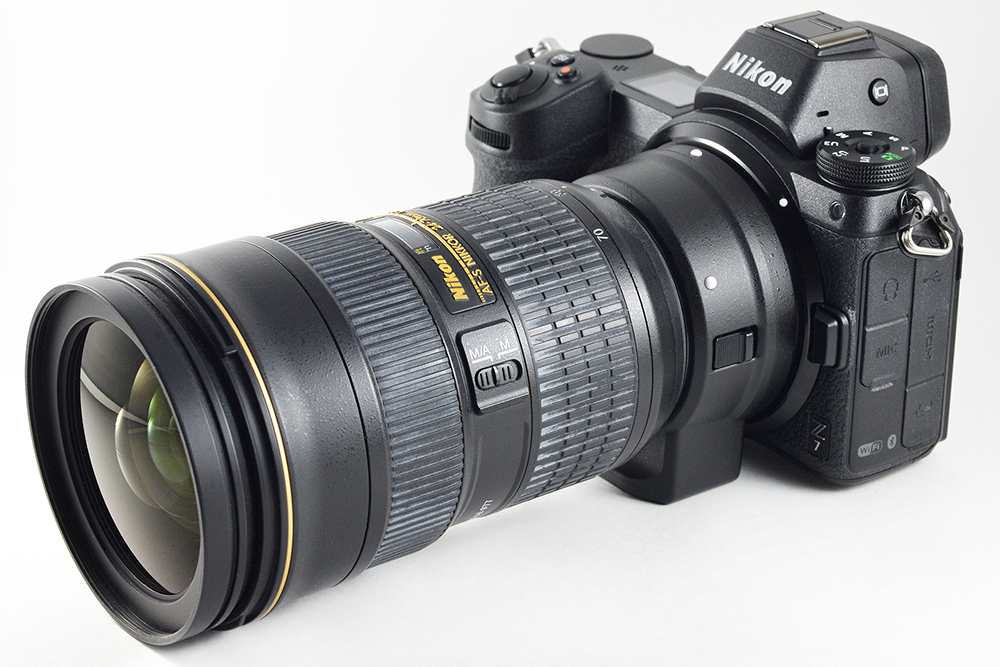One thing I have discovered today that I need to report to you. I spent several hours on the phone today with Nikon senior tech, learning some interesting things so that I can accurately write my upcoming Nikon Z 6 and Z 7 books.
The Nikon Z 7 (and Z 6) FTZ adapter allows you to use lenses registered with Non-CPU lens data in the Setup Menu. However, the FTZ adapter has no aperture indexing capability (no prong) for older AI/AI-S lenses. Therefore, the non-CPU lens data function in the Setup Menu is somewhat crippled. The camera apparently cannot use the aperture data you entered in the menu for anything more than labeling the image metadata with the maximum aperture, even if the image was taken with a smaller aperture.
For instance, if you took a picture at f/5.6 with an AI lens that has an F/1.8 maximum aperture, the metadata of the image will report F/1.8 and the correct shutter speed. Again, the FTZ adapter cannot physically transmit any aperture data to the camera body for a non-CPU lens. It works differently than what you are used to on your DSLR because there is no aperture prong on the FTZ adapter to report the current aperture in use. Therefore, you will need to use stop-down metering.

Nikon Z 7 with an FTZ adapter and pre-AI Nikkor-S 50mm f/1.4 lens
When you are using an AI/AI-S lens, you will notice that the shutter speed displays normally, but the aperture always displays as “F– –”. This is considered an error, even in the Nikon Z 6 and Z 7 manuals, where it states, “Lens is not correctly attached“. However, it is not an error in this case, it simply signifies that the FTZ adapter cannot pass aperture information to the camera body. Basically, to make a long story short, when you are using an AI or AI-S lens, the camera has no idea what aperture you are using.
Just be sure you understand how to meter a lens that cannot pass aperture information to the camera. Do some research on “stop-down metering”.
It really is a non-issue since the EVF can contain a live histogram to get accurate exposures. However, you do need to understand how to use a histogram for the best exposure with AI/AI-S lenses. If you have AI/AI-S lenses that you simply must use on a Z camera, you may want to have a CPU and electronic connections added to the lens. There are several companies that will do that for you at reasonable prices. If you add a CPU and electrical connections to an older lens, so that it can electrically communicate with the camera body, metering will function like a newer lens except that you will still need to manually focus the older MF lens.
Nikon Z 7 with an FTZ adapter and AF-S Nikkor 24-70mm f/2.8 G ED lens
Newer AF, AF-D, AF-S, AF-P, AF-I, and Z lenses can communicate with the camera body, passing the necessary information to let the camera meter the exposure correctly.
AF and AF-D lenses require you to manually focus the camera since there is no screw drive in the FTZ adapter to provide a focus motor for lenses that do not have built-in focus motors.
Newer Nikon lenses (AF-S, Z) fully autofocus and meter. I hope that Nikon improves on the FTZ adapter by adding some extra goodies, such as a screw drive and aperture indexing lever. However, I suspect that Nikon is inclined to push forward with mirrorless, develop new extremely high-quality lenses and some less costly ones too. I believe that Nikon will now gradually let DSLRs fade away along with the old lenses designed for the film days.
Whether or not we like it, the days of mirrorless are arising and the era of DSLRs will become the good old days of fat, heavy cameras with mirrors. One day, sooner than we expect, we will be remembering DSLRs with fondness—the cameras of our youth. You still have a choice and will for several more years though. However, put your toes in the mirrorless waters now, and learn the new ways, before the trickle of mirrorless becomes a wave that washes away any need to know how to use a DSLR.
Keep on capturing time…
Darrell Young

Darrell Young is an active member of the Nikonians User Community, Nikon Professional Services (NPS), Professional Photographers of America (PPA), North American Nature Photography Association (NANPA), and the author of 24 photography books from NikoniansPress and Picture and Pen Press, through Rocky Nook. You may review a few of Darrell’s Nikon books here. He has been an avid photographer since 1968 when his mother gave him a Brownie Hawkeye camera.
This website was created to support the readers of his educational books, photography students, and clients. Visitors to this website will find articles and reviews designed to inform, teach, and help you enjoy your photographic journey.
Join Darrell on Facebook and Twitter



With my Z6, I can use the older Ai lenses, without the data I don’t need (I’m a happy FM3a user) to use A and M modes, just fine.
Unfortunately, it’s my more recent AF Nikkors that demand being set to the maximum f/22 — which the camera display shows as f/19…and will not allow opening the aperture at all. The lens must be physically locked with the tab on the exteior of the lens barrel.
I hope this is due to an error on my part than Nikon’s. I pray this is something that can overwritten. The the FEE warning appears on the info display, and the shutter will not fire, in any mode.
Otherwise, this is a wonderful camera.
Thank you for sharing your guide to the Z6, and I hope you can advise me what to do.
Brian N.
Brian,
I have a couple of cameras here- a D810 and a Z6. I agree with what you’re seeing. On the D810, if you go to f9 you’ll see “Aperture setting” and when that’s turned off the F-ring on my 35mm 2.0 D lens works with hands directly, rather than the front command dial on the camera controlling the lens’s f-stop (with the lens stopped down to the max) as you know. So, the Z6 has been crippled here. Guess that’s in line with not having the mechanical aperture feeler on the FTZ adapter. Could test that on a 30xx or 50xx series camera to see, since I guess they don’t have feelers. I’m going to chip some lenses just to get the Ai lenses (or older) to communicate with the camera body for an exposure meter indicator ( -…0…+ ) to show at least. -Rob